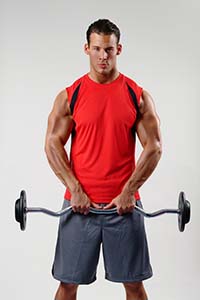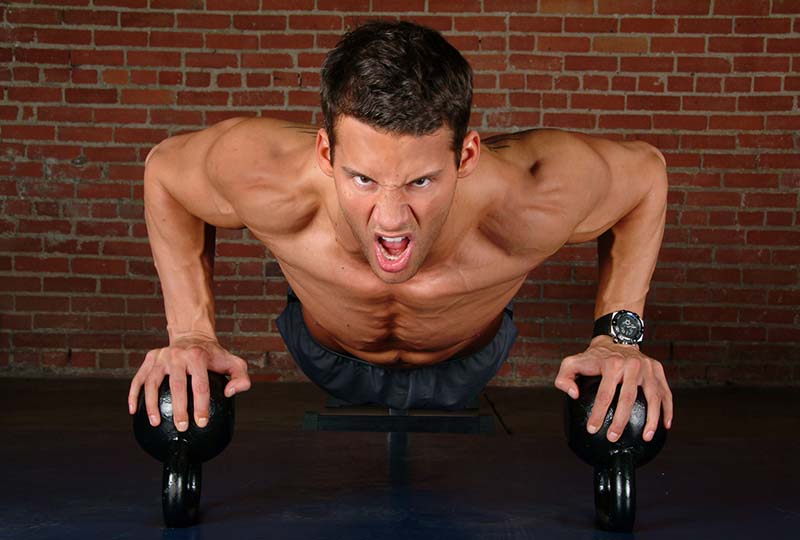Last Updated on January 22, 2024
Want to squeeze every last bit of muscle stimulation and growth out of your workouts? Do you have a serious pain tolerance and a desire to get bigger? If so, read on to learn a few intensity techniques that will take your gains to a whole new level!
The Problem With Strength Gains
Overall, gaining strength is the best plan for long-term muscle gains. This is because strength gains are a surefire form of PROGRESSION, the thing that really “matters” to your muscles. You can progress by adding sets and reps, as well, but that can only last so long! You can always keep adding weight to the bar…
However, your body needs a break from constantly heavier weights. You might have a couple months where you add five pounds to the bar every time you squat or bench, but if that lasted for a year, you’d make some (literally) impossible strength gains! In order to consistently get stronger AND bigger, you should try alternating your focus between strength and hypertrophy (muscle growth). This is where intensity techniques come in.
Intensity techniques are training methods which allow you to make your sets longer and more difficult, ultimately allowing you to do more work in the same time. This is why they are so great for building muscle! When you go from squatting 315 for 5 reps to 405 for 5 reps, you’re doing more work in the same time. When you then start doing 405 for 5, followed immediately by a set of 20 on the leg press, you’re also doing more work in the same time!
Dropsets
Dropsets are one of the simplest and most effective intensity techniques. To perform a dropset, just go to failure or near-failure with one weight, take some weight away, and go to failure again. Take the bench press for example. Maybe your best set so far is 315 for 5 reps. For a dropset, do your 5 reps with 315, reduce the weight to 225, and immediately get as many reps as you can with that weight! You might even want to take the weight down to 135 after that for a triple dropset.
The nice thing about dropsets is that it’s easy to see when you’re making progress. Let’s say the guy in the previous example got 5 reps with 225 after hitting 315 for 5. The next workout, he gets 6 reps with 225, and the next workout, he gets 8. Even though he got 315 for 5 every time, the total amount of work done in that set is clearly higher. That means more muscle!
Supersets
People often perform what they call “supersets” for opposing muscle groups. They’ll combine a biceps exercise and a triceps exercise, or they’ll do chest and back movements back-to-back with little rest. These methods are effective, but a real superset involves two or more exercises done in succession for the SAME muscle group!
If you choose your movements correctly, supersets can be awesome for getting the absolute most out of each set you do. Say you want to do close-grip bench presses for your triceps. Normally, when you hit failure on that movement, your chest and shoulders are fatigued, as well, but your triceps might still have some work left in them! To get every last bit of effort out of your tris, you go straight over to the cable station for some press-downs, hitting 10-15 reps until your arms are spent. Now THAT’S a set!
Overall, you probably want to pair an isolation movement with a compound movement to get the most out of a superset, and you want to do the compound movement first. For chest, you might hit a set of bench presses and immediately follow it with flies or cable crossovers. For legs, you might superset leg presses with leg extensions to torch your quads. Whatever you do, just make sure you’re using heavy weights AND getting everything you’ve got out of that muscle by the end of the set!
Pre-Exhaustion

Similar to supersets, pre-exhaustion involves working a muscle with an isolation movement BEFORE hitting it hard and heavy with a compound exercise. This can be done in superset fashion, one movement right after the other, but you can also complete all sets of one exercise before moving onto the other. Overall, it’s a great method for feeling a good mind-muscle connection and bringing up lagging body parts.
Some guys have a lot of trouble building their chests, even though they can bench a lot of weight. Their problem is that their shoulders and triceps take over in the movement, limiting the work their pecs can do. To solve this problem, try doing a few hard sets of 15-20 on the cable crossover. THEN, go and bench press, making sure to focus the effort on your already-fatigued pecs – you’ll be able to feel the mind-muscle connection way better! You can’t use as much weight, but you will build your chest better than if you just heaved heavy poundages around.
The Right Workout for Intensity Techniques
If you’re going to switch focus from strength to pure muscle-building and use techniques like these, you might to change your workout schedule, as well. Upper-lower body splits and a focus on basic movements is great for building maximal strength, but you’ll have to start thinking about muscles and body parts for a while. Don’t think “bench day” or “squat day,” think “chest day” and “leg day.” Of course you’re still doing those hard, heavy exercises, but your focus is on making the individual muscles grow! Justin Woltering.







